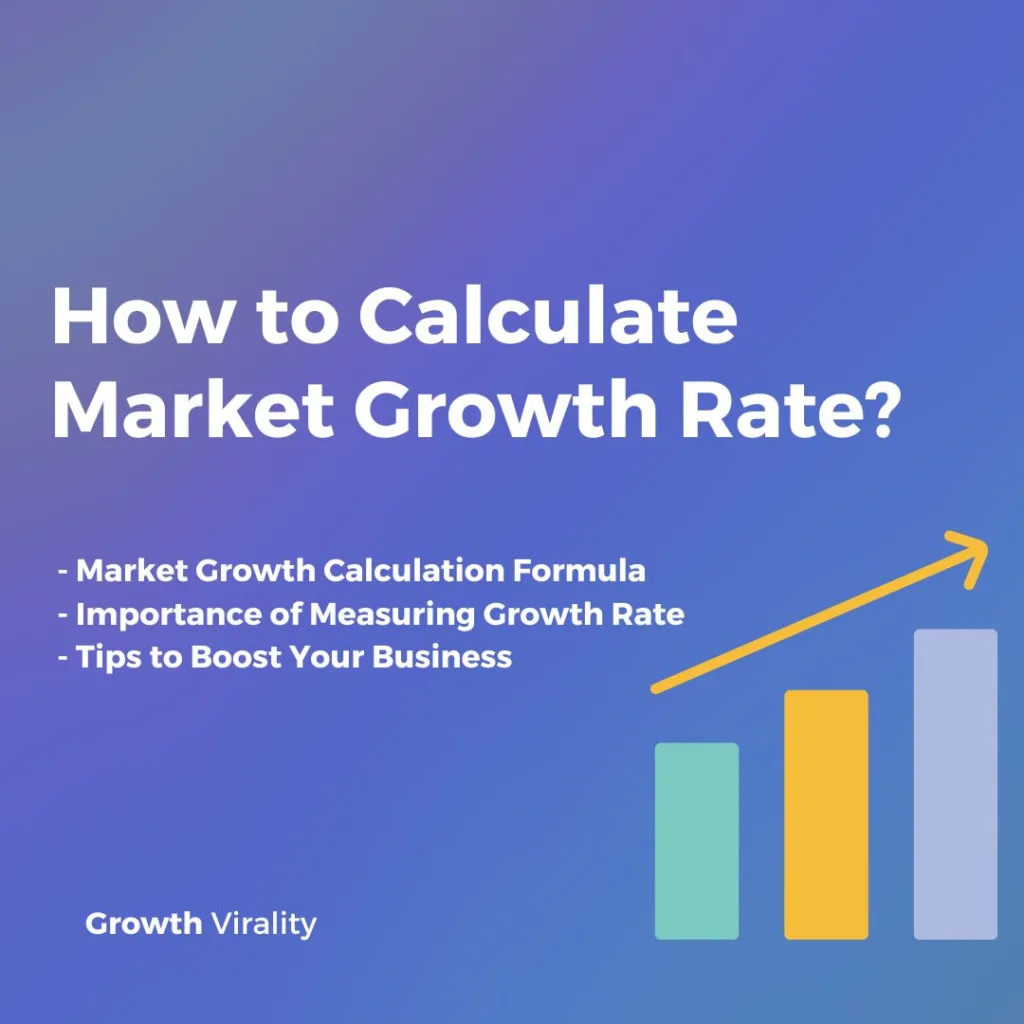Starting a new business journey feels like sailing into the unknown.
We all wish we could predict if our business will do well.
Even though we can’t predict everything, there’s a handy tool called the market growth rate.
Knowing about market growth is like having a map. It helps businesses spend their money wisely, find places to grow, and adjust to customers’ wants.
Want to know more about market growth and how to figure it out? Let’s learn!
Key Takeaways:
- Market growth is essential for business success, guiding resource allocation, expansion, and adaptation to customer demands.
- Increased demand, technological advancements, emergence of new customer segments, and strategic planning contribute to market growth.
- Market share emphasizes a company’s position, while market growth focuses on overall expansion and health of the entire market.
- Calculating market growth rate helps quantify the percentage increase or decrease in market size over a specified period.
What is Market Growth?
Market growth means how much a certain market has grown in size and value over a certain time. It shows if a market is doing well and has good chances for success.
Industry expansion can be driven by factors such as:
- Increased demand
- Technological advancements
- Emergence of new customer segments
- Analysis of metrics like sales, revenue, and customer base expansion
- Identification of lucrative investment areas
- Strategic expansion planning
- Maintaining competitiveness in evolving industries
Need a marketing agency to improve your branding? Use our Agency Match Maker to find the best marketing company
Market Share Vs. Market Growth
| Criteria | Market Share | Market Growth |
| Definition | Percentage of total market sales or revenue held by a company or product. | The percentage increase in the overall size and value of a market over a specific period. |
| Focus | Emphasizes a company’s position within the existing market. | Concentrates on the expansion and overall health of the entire market. |
| Calculation | Company’s sales or revenue divided by total market sales or revenue, multiplied by 100. | Change in market size or value over a defined period, expressed as a percentage. |
| Objective | Reflects a company’s competitiveness within its current market. | Indicates the potential for new opportunities, demand, and overall market viability. |
| Strategy Implications | Companies want to sell more of their products than other companies. They try to do this by offering good prices, making their products stand out, or advertising to certain groups of people. | Businesses focus on innovation, entering new markets, or capitalizing on emerging trends to drive overall market growth. |
| Key Performance Indicator | Specific to individual companies or products. | Reflects the overall health and attractiveness of the entire market. |
Why is it Important To Calculate Market Growth?
Calculating market growth is important for the following reasons:
- TAM Expansion: Calculating market growth provides insights into the Total Addressable Market, guiding marketers in understanding the overall market potential.
- IAM Identification: It helps discern the Incremental Addressable Market, enabling marketers to pinpoint specific growth areas and identify untapped opportunities.
- Resource Optimization: Market growth analytics inform precise resource allocation, optimizing Return on Marketing Investment (ROMI) for efficient and effective campaigns.
- First Mover Advantage: Marketers can leverage market growth insights to align strategies with Early Adopter Segments, gaining a competitive edge through the First Mover Advantage.
- Brand Equity Enhancement: A calculated approach rooted in market growth analytics enhances Brand Equity, establishing businesses as industry leaders and innovators in dynamic market landscapes.
- Risk Management: Market growth data assists in risk assessment. Businesses can anticipate and mitigate risks associated with slow or negative growth by diversifying, exploring new markets, or innovating.
- Performance Evaluation: For businesses, tracking market growth provides a benchmark for evaluating their performance. It allows them to measure their success compared to the overall market conditions.
Also See: Most Powerful Growth Marketing Channels
How to Calculate Market Growth?
The formula to calculate market growth is:
Market Growth Rate = ( Current Market Size − Previous Market Size/ Previous Market Size ) × 100
Here is how to measure market growth accurately:
- Pick a Time Frame: Choose a specific period, like every three months or once a year, to figure out how the market is growing.
- Get Current and Past Sizes: Find out how big the market is now and how big it was in the previous period. This could be sales, units sold, or other relevant numbers.
- Use the Formula: Put the numbers into the formula we talked about earlier.
- Measure the Market Growth Rate: Do some math: subtract the old size from the new one, divide that by the old size, and then multiply by 100 to get the growth rate as a percentage.
A positive growth rate means the market is getting bigger – it’s expanding. This shows that the market is growing in size. On the flip side, a negative growth rate means the market is getting smaller – it’s contracting. This indicates a decrease in the market size. The percentage tells us how fast or intense this growth or shrinkage is happening.
Also See: 80 Best Marketing Companies & Services
Example of Market Growth Rate Calculation
Imagine last year a local market had $1 million in sales, and this year it increased to $1.5 million.
To calculate the market growth rate:
Market Growth Rate = ( New Sales − Old Sales/ Old Sales ) × 100
Market Growth Rate=( 1 1.5−1 )×100=50%
This means the market experienced a 50% growth in sales from last year to this year.
Also See: How to Create a Growth Marketing Funnel?
Top Tips To Boost Your Firm’s Market Presence
Here are the top tips to improve your company’s market presence:
- Increase Customer Retention Rates: Employ cross-selling tactics to increase loyalty. You can also employ a customer loyalty program to foster stronger connections while personalizing the buyer’s journey, which enhances the overall customer experience. Introduce recurring subscription options to cater to convenience-seeking customers.
- Create New Products: Start by formulating a comprehensive product development strategy encompassing your concept, timeframes, market needs, and implementation plans. Evaluate ideas based on feasibility, profitability, market fit, and alignment with your business goals.
- Expand Into New Territories: Use a ‘digital-first’ approach for cost-effective and scalable expansion and modeling marketing efforts on successful international competitors.
- Use New Sales Channels: Leverage the power of e-commerce platforms, online marketplaces, and strategic partnerships. Use new-age channels like social and mobile commerce, and even consider emerging technologies like voice commerce.
- Invest in New Technologies: Technologies like augmented reality, virtual reality, and blockchain can offer unique customer experiences and secure transactions, contributing to increased competitiveness and helping you increase your market share.
- Acquire Competitors: Buy businesses with a history of positive cash flow or those displaying robust growth potential. Leverage your industry familiarity by focusing on businesses within your niche. Opt for enterprises with a diverse customer base, as they are more resilient to market fluctuations and provide a stable revenue stream.
- Reduce Pricing: You can consider volume discounts and temporary promotions to stimulate sales without compromising long-term profitability. Monitor the impact on revenue and customer perceptions to make informed adjustments for a balanced pricing strategy.
Also See: Difference Between Demand Generation and Growth Marketing
FAQs
What is a good market growth rate?
A good market growth rate varies depending on the industry, economic conditions, and other factors. Generally, a healthy market growth rate should exceed the economy’s overall growth rate or gross domestic product (GDP). You should aim for a growth rate between 15% and 20% per year.
How can businesses capitalize on market growth?
Businesses can capitalize on market growth by:
- Identifying and targeting growing market segments
- Adapting products/services to meet evolving needs
- Investing strategically in high-growth areas
- Enhancing marketing and brand visibility
- Expanding product/service offerings
- Strengthening customer relationship management
- Fostering innovation and continuous improvement
- Building strategic partnerships and collaborations
Also See: Discover the best marketing tools to supercharge your growth
What role does innovation play in market growth?
Innovation is often a catalyst for market growth. Companies that introduce new and improved products or services can capture consumer interest, drive demand, and contribute to the market’s overall expansion.
What challenges can businesses face in a rapidly growing market?
In a rapidly growing market, businesses often grapple with the following challenges:
- Intensified competition
- Strained supply chains
- Rapid scaling complexities
- Increased customer expectations
- Maintaining service consistency
- Balancing innovation and immediate demands
- Strategic navigation complexities

